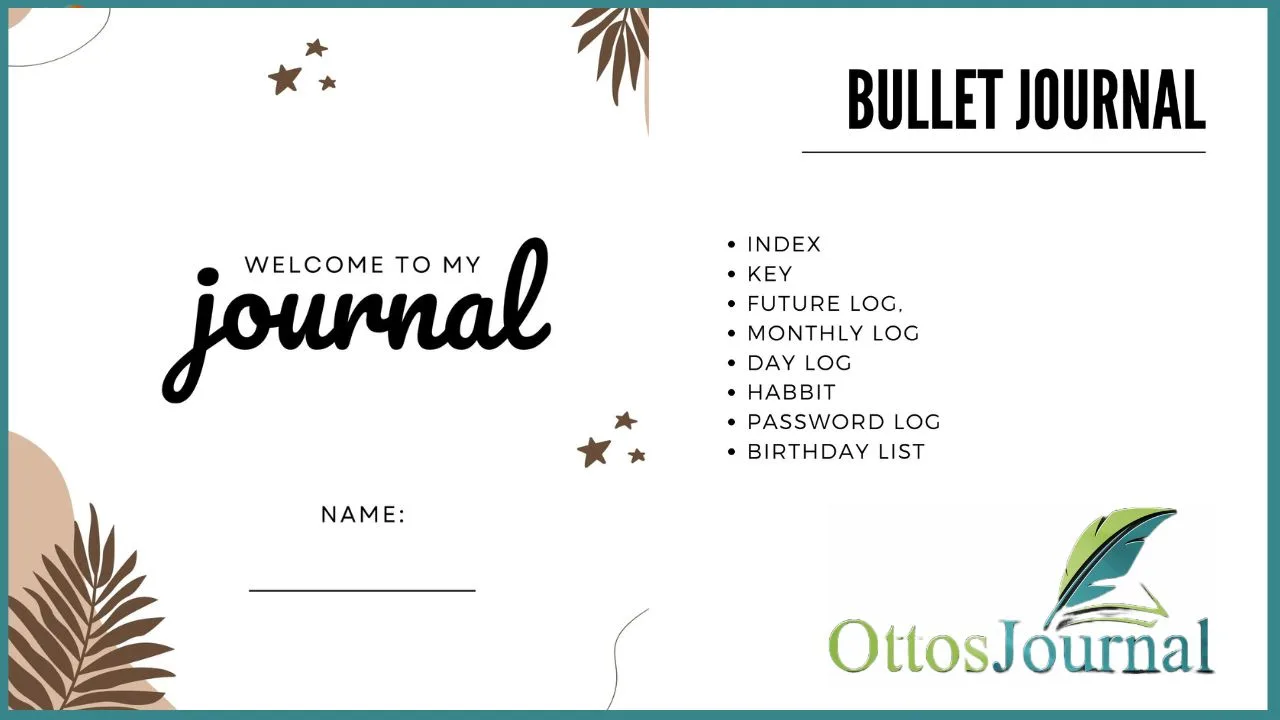Bullet journaling is a form of time management that allows you to keep track of your tasks, appointments, thoughts, ideas, and more. Bullet journal forces you to organize your life in both the short-term and long-term. For those who want to take their time management skills to a whole new level, bullet journaling can be a great way to organize your tasks and stay on top of them. In this blog post, I will show you how to start a bullet journal for time management and provide you with bullet journal ideas to help you get started.
How to start bullet journal for time management.
Here’s how to start bullet journal for time management;
Choose a System
The first step in the bullet journal method is to decide on a system that works for you. You can choose from a variety of templates or create your own. Consider what type of information you want to track and how often you will be using the journal.
Create a Layout
Your journal should have an organized layout that clearly outlines what needs to be done each day, week, or month.
Designate sections for different areas of your life such as work, family, health, and hobbies. This will make it easier to stay focused on important tasks. You can also add symbols or colors to help you quickly identify and prioritize tasks.
Start with a To-Do List
The best way to get started with your writing process is by creating a daily and weekly to-do list that includes both short-term and long-term goals. This will help you stay organized and on track.
Establish Routines
Once you have a good to-do list, it’s time to create routines and habits that will help you stay productive. Identify how many tasks that need to be done every day or week and make sure you set aside the necessary time for them each day.
Assign Time for Tasks
After establishing your routines, the next step is to assign time for each task. This will help you stay on track and make sure that you’re completing tasks promptly.
Schedule Breaks
Don’t forget to schedule breaks throughout the day as well. This will help prevent burnout and give you time to recharge and relax.
Track Your Progress
As you go through your time management, make sure to track your progress with a monthly review or goal-setting page. This will help you stay motivated and on top of your tasks.
Use Labels Effectively
To help you stay organized, use labels to categorize and prioritize tasks in your bullet journal. This will make it easier to find tasks and stay on track.
Don’t Overwhelm Yourself
Last, but not least, try not to overwhelm yourself when creating a bullet journal system for time management. Start with small goals and tasks that are manageable. Once you master those, then move on to bigger projects and goals.
Tools and Tips for Time Management Bullet Journaling
Starting a bullet journal for time management can be overwhelming, but with the right tools and supplies, you’ll be able to get started quickly and easily. Here are some must-have items for your bullet journal:
Notebooks/Journals
Choose a durable journal that has enough pages so you can add new information as you go along.
Pens & Pencils
Make sure you have the right supplies for your bullet journal, such as various colors and sizes of pens and pencils.
Stickers & Washi Tape
These can be used to decorate pages and add splashes of color.
Sticky Notes
Sticky notes are a great way to quickly and easily make lists, set reminders, and track progress.
Index Cards
Use index cards to keep track of tasks that you need to complete.
Planner
Planners are great digital tools for keeping track of events, appointments, and other important deadlines.
Calendar Pages
Calendar pages are a must-have for any bullet journal. It will help you see the big picture and plan ahead.
Time Management Bullet journal ideas
1. Create a daily routine for yourself in your time log and stick to it.
2. Establish weekly goals and track your progress with a monthly review page.
3. Make a list of priorities each day, week, or month and use labels to categorize all the tasks according to importance.
4. Schedule regular breaks for a few minutes per day to give yourself time to relax and recharge.
5. Use a weekly calendar page to plan out your week in advance.
6. Write down ideas for projects or tasks that come to mind so you don’t forget them later on.
7. Track books, movies, or documentaries you want to watch or read by creating a list in your bullet journal.
8. Create a habit tracker page to keep track of habits you want to form or break.
9. Create a “Daily Log” at the beginning of each day and check off items as you complete them throughout the day.
10. Schedule self-care activities into your routine like yoga, meditation, walking, etc., so that they become part of your daily routine.
11. Make a list of short-term and long-term goals so that you can always keep them in mind.
12. Use color coding to track tasks and activities for different categories like work, school, or home life.
13. Establish deadlines for yourself and check off items as you complete them in order to stay on track with projects and tasks.
14. Write down ideas for blog posts, stories, or other creative projects in your bullet journal so that you don’t forget them later on.
15. Create a “Brain Dump” page at the beginning of each month where you can jot down any thoughts or ideas that come to mind.
16. Create a “Daily Gratitude List” at the end of each day to remind yourself of all the things you are thankful for.
17. Designate a page in your bullet journal as an inspiration board where you can write down quotes or ideas that inspire you.
18. Set aside time each week for reflection and goal setting in your bullet journal time tracker so that you can review what has been accomplished and adjust future goals or plans in your future log accordingly.
19. Create a page dedicated to tracking your daily steps or exercise routine so that you can stay on top of your health and fitness goals.
20. Track your progress with project-based goals by creating an index card system for each one, labeling them according to priority.
How to Organize Bullet Journals for Time Management
Create Index
Indexes are great for quickly jotting down tasks or ideas without having to write out the entire thing. Label the index according to priority and keep them in a separate section of your bullet journal so they’re easy to find when you need them.
Allocate Space for Lists & Notes
Make sure to leave enough space in your bullet journal for lists and notes. This will help you keep track of ideas, tasks, or events that come up throughout the day.
Set Up Monthly Calendars & Reviews
At the beginning of each month, set up a page in your bullet journal with a calendar to plan out activities for the upcoming month as well as review pages to track progress on goals. This will help you stay organized and on top of tasks.
Keep a Master List of Tasks
To help keep track of all your tasks, create a master list in the back of your bullet journal. Label each task according to priority level and cross off items as they’re completed. This will help you stay organized and motivated throughout the month.
Label Each Page
Make sure to label each page in your bullet journal so that you know what it is referring to at first glance. This will make it easier to find a specific page or topic in your bullet journal quickly.
Use Different Layouts
Try out different layouts when creating your bullet journal pages to make them more interesting and engaging. You can mix up the layout with cute drawings, charts, graphs, headers, etc., depending on how creative you want to get.
Make Your Own Symbols
Create your own unique symbols for tracking tasks or events in your bullet journal. This will help you quickly identify what type of task or event it is at a glance, and also make your bullet journal look more organized.
Create A Visual Timeline
If you’re working on long-term projects that require time tracking, use a visual timeline to keep track of progress. This will help you stay organized and motivated as you move toward completing the project!
Tips to Make Your Bullet Journal for Time Management a Success
Set Goals
Establish goals for yourself in your bullet journal, such as completing projects on time or reducing stress. This will give you direction and help keep you motivated to stay organized with your bullet journal.
Schedule Regular Reviews
Schedule regular reviews of previous tasks and events so that you can adjust plans accordingly. This will help you stay on top of long-term projects and tasks that require multiple steps or deadlines.
Be Creative
Get creative with your bullet journal and add drawings, charts, graphs, or other elements to keep it interesting. This will help keep you motivated and engaged when working in your bullet journal.
Use Visual Aids
Use visuals like charts, graphs, or diagrams to show progress in your bullet journal. This will make it easier to keep track of what needs to be done and stay motivated.
Enjoy The Process
Don’t forget to take a moment to appreciate all of the hard work and dedication that goes into creating and maintaining a successful bullet journal for time management.
Bottom line
Using a bullet journal for time management is a great way to stay organized and productive. With the right tools and time management techniques, you can create a well-organized bullet journal that will help keep track of tasks, events, and goals effectively.
Just remember to have fun with it! Once you start using your bullet journal regularly, you’ll be able to see how much easier it is to manage your time and organize tasks more efficiently.
Now that you know how to start a bullet journal for time management, it’s time to get started! Don’t forget to schedule regular reviews of your bullet journal and check in with yourself often.




